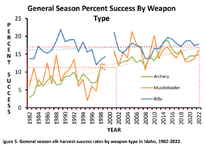idelkslayer
WKR
I came across this graph while reading through some Idaho elk management information. The effects of advancing technology on harvest success has been debated in the past but this is the first time I've seen a graph that illustrates how this has changed over time. I did some quick looking at past general season harvest stats to see what else might be contributing to the increasing success rates of "primitive" weapons.
I looked at harvest stats from 2023 and 2001 to compare general archery and rifle seasons. I was curious how the month long archery seasons might play a role compared to the 2-3 week long rifle seasons typical across Idaho. The average rifle hunter spent 5.6 days in the field compared to 7.5 day average for archery hunters. So we see that for an archer to achieve success near the rate of rifle hunters requires nearly 2 more days of hunting.
Archery hunters in 2023 spent 10% more time in the field than archery hunters in 2001 (6.8 days). I interpret this to mean that some of the increased success of archery hunters could be attributed to more time spent in the field. By comparison rifle hunters also increased their time in the field from an average of 4.6 days in 2001 to 5.6 days in 2023. The additional day of rifle hunting didn't change success rates much. This appears to support the idea that technology definitely plays a role in the increased success of archery hunters. But I do think it is still a combination of increased time afield and advancing technology.
The total number of archery hunters increased from ~15,000 in 2001 to ~27,000 in 2023. Rifle hunters went from ~41,000 in 2001 to ~48,000 in 2023. In some Idaho elk zones there is overlap in archery and rifle elk hunters as some zones allow hunters to participate in both. Elk populations and total harvest have also increased over that 20 year period. It seems like the growing elk population was more or less able to keep up with increasing harvest success.
My preliminary conclusion is that the increase in archery/muzzleloader success rates has been sustainable so far because the elk population has grown enough to keep up with the technology. Idaho sustained a steady 20,000+ harvest for the last 10 years (with the exception of 2023) If the technology continues to increase or if current technology becomes more easily available, it could lead to changes in archery and muzzleloader season structure and opportunity in the future.
It is also interesting to see how little the rifle success rate has changed in the 40 years depicted in the graph. Advancements in long range hunting tech appear to have had a much smaller effect on harvest success than those in the archery and muzzleloader world.

I looked at harvest stats from 2023 and 2001 to compare general archery and rifle seasons. I was curious how the month long archery seasons might play a role compared to the 2-3 week long rifle seasons typical across Idaho. The average rifle hunter spent 5.6 days in the field compared to 7.5 day average for archery hunters. So we see that for an archer to achieve success near the rate of rifle hunters requires nearly 2 more days of hunting.
Archery hunters in 2023 spent 10% more time in the field than archery hunters in 2001 (6.8 days). I interpret this to mean that some of the increased success of archery hunters could be attributed to more time spent in the field. By comparison rifle hunters also increased their time in the field from an average of 4.6 days in 2001 to 5.6 days in 2023. The additional day of rifle hunting didn't change success rates much. This appears to support the idea that technology definitely plays a role in the increased success of archery hunters. But I do think it is still a combination of increased time afield and advancing technology.
The total number of archery hunters increased from ~15,000 in 2001 to ~27,000 in 2023. Rifle hunters went from ~41,000 in 2001 to ~48,000 in 2023. In some Idaho elk zones there is overlap in archery and rifle elk hunters as some zones allow hunters to participate in both. Elk populations and total harvest have also increased over that 20 year period. It seems like the growing elk population was more or less able to keep up with increasing harvest success.
My preliminary conclusion is that the increase in archery/muzzleloader success rates has been sustainable so far because the elk population has grown enough to keep up with the technology. Idaho sustained a steady 20,000+ harvest for the last 10 years (with the exception of 2023) If the technology continues to increase or if current technology becomes more easily available, it could lead to changes in archery and muzzleloader season structure and opportunity in the future.
It is also interesting to see how little the rifle success rate has changed in the 40 years depicted in the graph. Advancements in long range hunting tech appear to have had a much smaller effect on harvest success than those in the archery and muzzleloader world.

